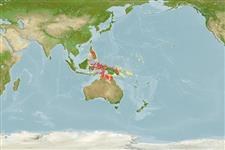Actinopterygii (ray-finned fishes) >
Pleuronectiformes (Flatfishes) >
Soleidae (Soles)
Etymology: Zebrias: Derived from Zebra = African horse, referring to the stripes (Ref. 45335).
Environment / Climate / Range
Ecology
Marine; demersal. Tropical, preferred ?
Western Central Pacific: known only from the Lingayen Gulf, Philippines.
Size / Weight / Age
Maturity: Lm ? range ? - ? cm
Max length : 8.4 cm TL male/unsexed; (Ref. 6340)
Short description
Morphology | Morphometrics
Dorsal
spines
(total): 0;
Dorsal
soft rays
(total): 71-72;
Anal
spines: 0;
Anal
soft rays: 56;
Vertebrae: 43. Preserved, ocular side light greyish-brown with 16-18 narrow, dark bands on body reaching the dorsal and anal fins. Blind side of body generally white with scattered spots, becoming dusky toward body margins. Eyes contiguous with upper eye slightly in advance of the lower; no interorbital scales. Opercular margins with minute tentacles. Ctenoid scales on both sides of the body; tubed lateral line scales cycloid.
Life cycle and mating behavior
Maturity | Reproduction | Spawning | Eggs | Fecundity | Larvae
Seigel, J.A. and T.A. Adamson, 1985. First record of the genus Zebrias (Pisces: Pleuronectiformes: Soleidae) from the Philippine Islands, with the description of a new species. Proc. Biol. Soc. Wash. 98(1):13-16. (Ref. 6340)
IUCN Red List Status (Ref. 115185)
CITES (Ref. 94142)
Not Evaluated
Threat to humans
Harmless
Human uses
More information
Common namesSynonymsMetabolismPredatorsEcotoxicologyReproductionMaturitySpawningFecundityEggsEgg development
Age/SizeGrowthLength-weightLength-lengthLength-frequenciesMorphometricsMorphologyLarvaeLarval dynamicsRecruitmentAbundance
ReferencesAquacultureAquaculture profileStrainsGeneticsAllele frequenciesHeritabilityDiseasesProcessingMass conversion
Tools
Special reports
Download XML
Internet sources
